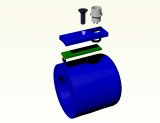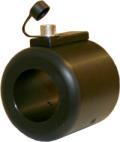ENC820
A tough hollow shaft encoder
The use of survey wheels with encoders in ground penetrating radar surveys seems ubiquitous. They are use to control the scan rate of radar units or to place marks in the collected data to be able to locate the anomalies later on.
Different manufacturers have implemented innovative ways for establishing the precise x&y location of the collected data. Radio beacons, laser pointers, RF grids, LED narrow beams to mention a few have been with more or less degree of success implemented. However, still Today it is the humble survey wheel in contact with the ground the work horse for this kind of applications.
In the last years a tendency towards GPS fixed data have been emerging constantly and the use of GPS loggers together with ground penetrating radar units are well recognized and used everywhere. There is still a problem with GPS positioning, no matter how exact and probably expensive GPS receiver you buy it will not offer the kind of resolution and accuracy that the survey wheel encoder provides.
There are a plethora of manufacturers offering different kind of encoders with different shaft diameters, pulse rate, maximum r.p.m etc. So, why invent the wheel again and make our own?
The North is not for the faint of heart!
We work almost seven month of the year with temperatures below zero and plenty of snow. It is not uncommon at all that lots of snow gets stuck in the wheels and subsequently the encoder as well. This melting snow corrode the parts of many encoders we have tried over the years, even the anodized aluminum ones get this nasty white oxide layer that makes them unusable after awhile. We needed something that was not afraid of low temperatures, water, dust, dirt and all the pleasant features usually accompanying the geophysicist in their daily work.
Another problem that we found was that almost all the encoders that we could find demanded a fifth wheel due to the small shaft diameter available. Lots of tweaking and adapting were in demand for getting the thing to work.
After considering all the pros and cons we finally decided to go for our own solution. You can profit Today from the result of many years of engineering and search for the ideal solution.
What else do you need?
Obviously you need a cable that can connect to our encoder, but that you can find in the cables section of this website. Another thing that is necessary is to have an axis in your cart with the proper dimensions, but otherwise it is not difficult at all to attach, adjust and use our ENC820.
The use of survey wheels with encoders in ground penetrating radar surveys seems ubiquitous. They are use to control the scan rate of radar units or to place marks in the collected data to be able to locate the anomalies later on.
Different manufacturers have implemented innovative ways for establishing the precise x&y location of the collected data. Radio beacons, laser pointers, RF grids, LED narrow beams to mention a few have been with more or less degree of success implemented. However, still Today it is the humble survey wheel in contact with the ground the work horse for this kind of applications.
In the last years a tendency towards GPS fixed data have been emerging constantly and the use of GPS loggers together with ground penetrating radar units are well recognized and used everywhere. There is still a problem with GPS positioning, no matter how exact and probably expensive GPS receiver you buy it will not offer the kind of resolution and accuracy that the survey wheel encoder provides.
There are a plethora of manufacturers offering different kind of encoders with different shaft diameters, pulse rate, maximum r.p.m etc. So, why invent the wheel again and make our own?
The North is not for the faint of heart!
We work almost seven month of the year with temperatures below zero and plenty of snow. It is not uncommon at all that lots of snow gets stuck in the wheels and subsequently the encoder as well. This melting snow corrode the parts of many encoders we have tried over the years, even the anodized aluminum ones get this nasty white oxide layer that makes them unusable after awhile. We needed something that was not afraid of low temperatures, water, dust, dirt and all the pleasant features usually accompanying the geophysicist in their daily work.
Another problem that we found was that almost all the encoders that we could find demanded a fifth wheel due to the small shaft diameter available. Lots of tweaking and adapting were in demand for getting the thing to work.
After considering all the pros and cons we finally decided to go for our own solution. You can profit Today from the result of many years of engineering and search for the ideal solution.
What else do you need?
Obviously you need a cable that can connect to our encoder, but that you can find in the cables section of this website. Another thing that is necessary is to have an axis in your cart with the proper dimensions, but otherwise it is not difficult at all to attach, adjust and use our ENC820.


 Svenska
Svenska Español
Español English
English

